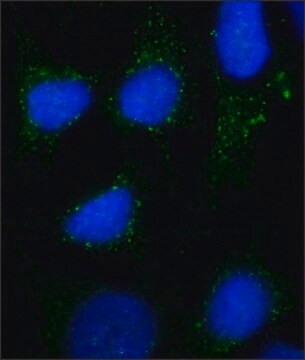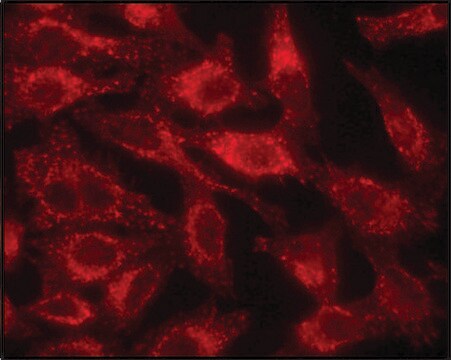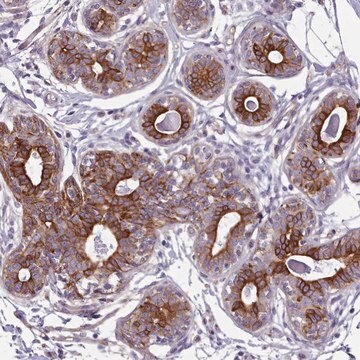추천 제품
생물학적 소스
mouse
Quality Level
항체 형태
purified immunoglobulin
항체 생산 유형
primary antibodies
클론
6C4, monoclonal
종 반응성(상동성에 의해 예측)
all
기술
ELISA: suitable
dot blot: suitable
electron microscopy: suitable
immunocytochemistry: suitable
동형
IgG1κ
배송 상태
wet ice
타겟 번역 후 변형
unmodified
유전자 정보
bacterial ... Lbpa(61281717)
일반 설명
Lyso bis-phosphatidic acid (LBPA, Lysobisphosphatidic acid, L(bis)PA) is a lipid that is exclusively located in late endosomes and is used as a late endosome marker. One of the characteristic features of late endosomes is a complex system of internal membranes within the lumen that contains large amounts of the unique, poorly degradable LBPA, and thus forms a specialized membrane domain within endosomes. Late endosomes function not only as a major protein-sorting compartment, but also an obligatory station for LDL and other endocytosed ligands destined for degradation. Research shows that the LBPA-rich membranes within late endosomes regulate cholesterol transport, presumably by acting as a collection and distribution device. The genetic disease Niemann–Pick type C (NPC) is characterized by both lysosomal and endosomal storage disorders. In skin fibroblasts from NPC patients, cholesterol accumulation is seen within vesicles containing late endosome markers LBPA and Rab7.
특이성
Clone 6C4 specifically detects LBPA, but not PC, PE, SM, PS, CL, PI, Sul, Chol, Cer, or CE purified from baby hamster kidney (BHK) cell lipid extract (Kobayahsi, T., et al. (1998). Nature. 392(6672):193-197).
Target molecule is not species-specific.
면역원
Endosomal membranes from baby hamster kidney fibroblasts (BHK) corresponding to Hamster LBPA.
애플리케이션
Immunocytochemistry Analysis: 4.0 µg/mL from a representative lot detected LBPA in A431, HUVEC and NIH/3T3 cells.
Immunocytochemistry Analysis: A representative lot detected late endosome LBPA immunoreactivity by fluorescent immunocytochemistry using MLN64-overexpressing MCF7 cells (Alpy, F., et al. (2001). J Biol Chem. 276(6):4261-4269).
Immunocytochemistry Analysis: A representative lot detected late endosome LBPA immunoreactivity in skin fibroblasts from healthy donors, as well as Niemann–Pick type C (NPC) and Tay-Sachs disease patients by fluorescent immunocytochemistry (Kobayahsi, T., et al. (1999). Nat Cell Biol. 1(2):113-118).
Immunocytochemistry Analysis: A representative lot detected late endosome LBPA immunoreactivity in baby hamster kidney (BHK) cells by fluorescent immunocytochemistry (Kobayahsi, T., et al. (1998). Nature. 392(6672):193-197).
Electron Microscopy Analysis: A representative lot detected similar cellular LBPA distribution in the skin fibroblasts from autosomal recessive Niemann–Pick type C disease (NPC) patients as seen in baby hamster kidney (BHK) cells (Kobayahsi, T., et al. (1999). Nat Cell Biol. 1(2):113-118).
Electron Microscopy Analysis: A representative lot detected LBPA immunoreactivity specifically associated with the late endosomes in baby hamster kidney (BHK) cells, but not the lgp120-positive limiting membranes of the same endosomes (Kobayahsi, T., et al. (1998). Nature. 392(6672):193-197).
ELISA Analysis: A representative lot specifically detected wells coated with total baby hamster kidney (BHK) cell lipid extract or purified LBPA, but not other lipids (PC, PE, SM, PS, CL, or PI) purified BHK lipid extract (Kobayahsi, T., et al. (1998). Nature. 392(6672):193-197)
Dot Blot Analysis: A representative lot specifically detected purified LBPA spotted on a HPTLC plate, but not other lipids (PC, PE, SM, PS, CL, PI, Sul, Chol, Cer, CE) purified from baby hamster kidney (BHK) cell lipid extract (Kobayahsi, T., et al. (1998). Nature. 392(6672):193-197).
Immunocytochemistry Analysis: A representative lot detected late endosome LBPA immunoreactivity by fluorescent immunocytochemistry using MLN64-overexpressing MCF7 cells (Alpy, F., et al. (2001). J Biol Chem. 276(6):4261-4269).
Immunocytochemistry Analysis: A representative lot detected late endosome LBPA immunoreactivity in skin fibroblasts from healthy donors, as well as Niemann–Pick type C (NPC) and Tay-Sachs disease patients by fluorescent immunocytochemistry (Kobayahsi, T., et al. (1999). Nat Cell Biol. 1(2):113-118).
Immunocytochemistry Analysis: A representative lot detected late endosome LBPA immunoreactivity in baby hamster kidney (BHK) cells by fluorescent immunocytochemistry (Kobayahsi, T., et al. (1998). Nature. 392(6672):193-197).
Electron Microscopy Analysis: A representative lot detected similar cellular LBPA distribution in the skin fibroblasts from autosomal recessive Niemann–Pick type C disease (NPC) patients as seen in baby hamster kidney (BHK) cells (Kobayahsi, T., et al. (1999). Nat Cell Biol. 1(2):113-118).
Electron Microscopy Analysis: A representative lot detected LBPA immunoreactivity specifically associated with the late endosomes in baby hamster kidney (BHK) cells, but not the lgp120-positive limiting membranes of the same endosomes (Kobayahsi, T., et al. (1998). Nature. 392(6672):193-197).
ELISA Analysis: A representative lot specifically detected wells coated with total baby hamster kidney (BHK) cell lipid extract or purified LBPA, but not other lipids (PC, PE, SM, PS, CL, or PI) purified BHK lipid extract (Kobayahsi, T., et al. (1998). Nature. 392(6672):193-197)
Dot Blot Analysis: A representative lot specifically detected purified LBPA spotted on a HPTLC plate, but not other lipids (PC, PE, SM, PS, CL, PI, Sul, Chol, Cer, CE) purified from baby hamster kidney (BHK) cell lipid extract (Kobayahsi, T., et al. (1998). Nature. 392(6672):193-197).
Research Category
Cell Structure
Cell Structure
Research Sub Category
Adhesion (CAMs)
Adhesion (CAMs)
This Anti-LBPA Antibody, clone 6C4 is validated for use in Immunocytochemistry, Electron Microscopy, ELISA and Dot Blot for the detection of LBPA.
품질
Evaluated by Immunocytochemistry in HeLa cells.
Immunocytochemistry Analysis: 4.0 µg/mL of this antibody stained late endosomes in HeLa cells.
Immunocytochemistry Analysis: 4.0 µg/mL of this antibody stained late endosomes in HeLa cells.
물리적 형태
Format: Purified
Protein G Purified
Purified mouse monoclonal IgG1κ antibody in buffer containing 0.1 M Tris-Glycine (pH 7.4), 150 mM NaCl with 0.05% sodium azide.
저장 및 안정성
Stable for 1 year at 2-8°C from date of receipt.
기타 정보
Concentration: Please refer to lot specific datasheet.
면책조항
Unless otherwise stated in our catalog or other company documentation accompanying the product(s), our products are intended for research use only and are not to be used for any other purpose, which includes but is not limited to, unauthorized commercial uses, in vitro diagnostic uses, ex vivo or in vivo therapeutic uses or any type of consumption or application to humans or animals.
적합한 제품을 찾을 수 없으신가요?
당사의 제품 선택기 도구.을(를) 시도해 보세요.
Storage Class Code
12 - Non Combustible Liquids
WGK
WGK 1
Flash Point (°F)
Not applicable
Flash Point (°C)
Not applicable
시험 성적서(COA)
제품의 로트/배치 번호를 입력하여 시험 성적서(COA)을 검색하십시오. 로트 및 배치 번호는 제품 라벨에 있는 ‘로트’ 또는 ‘배치’라는 용어 뒤에서 찾을 수 있습니다.
Late endosomal membranes rich in lysobisphosphatidic acid regulate cholesterol transport.
Kobayashi, T; Beuchat, MH; Lindsay, M; Frias, S; Palmiter, RD; Sakuraba, H; Parton, RG; Gruenberg, J
Nature Cell Biology null
Jessica Venugopal et al.
Scientific reports, 12(1), 16437-16437 (2022-10-01)
Sickle cell disease (SCD) is associated with altered plasma and erythrocyte lipid profiles. In a previous study, SCD mice with deficiency of proprotein convertase subtilisin/kexin type 9 (PCSK9) were observed to have more severe anemia and increased sickling compared to control
A lipid associated with the antiphospholipid syndrome regulates endosome structure and function.
Kobayashi, T; Stang, E; Fang, KS; de Moerloose, P; Parton, RG; Gruenberg, J
Nature null
F Alpy et al.
The Journal of biological chemistry, 276(6), 4261-4269 (2000-10-29)
MLN64 is a transmembrane protein that shares homology with the cholesterol binding domain (START domain) of the steroidogenic acute regulatory protein. The steroidogenic acute regulatory protein is located in the inner membrane of mitochondria, where it facilitates cholesterol import into
Ruochen Zang et al.
Proceedings of the National Academy of Sciences of the United States of America, 117(50), 32105-32113 (2020-11-27)
Cholesterol 25-hydroxylase (CH25H) is an interferon (IFN)-stimulated gene that shows broad antiviral activities against a wide range of enveloped viruses. Here, using an IFN-stimulated gene screen against vesicular stomatitis virus (VSV)-SARS-CoV and VSV-SARS-CoV-2 chimeric viruses, we identified CH25H and its
자사의 과학자팀은 생명 과학, 재료 과학, 화학 합성, 크로마토그래피, 분석 및 기타 많은 영역을 포함한 모든 과학 분야에 경험이 있습니다..
고객지원팀으로 연락바랍니다.






